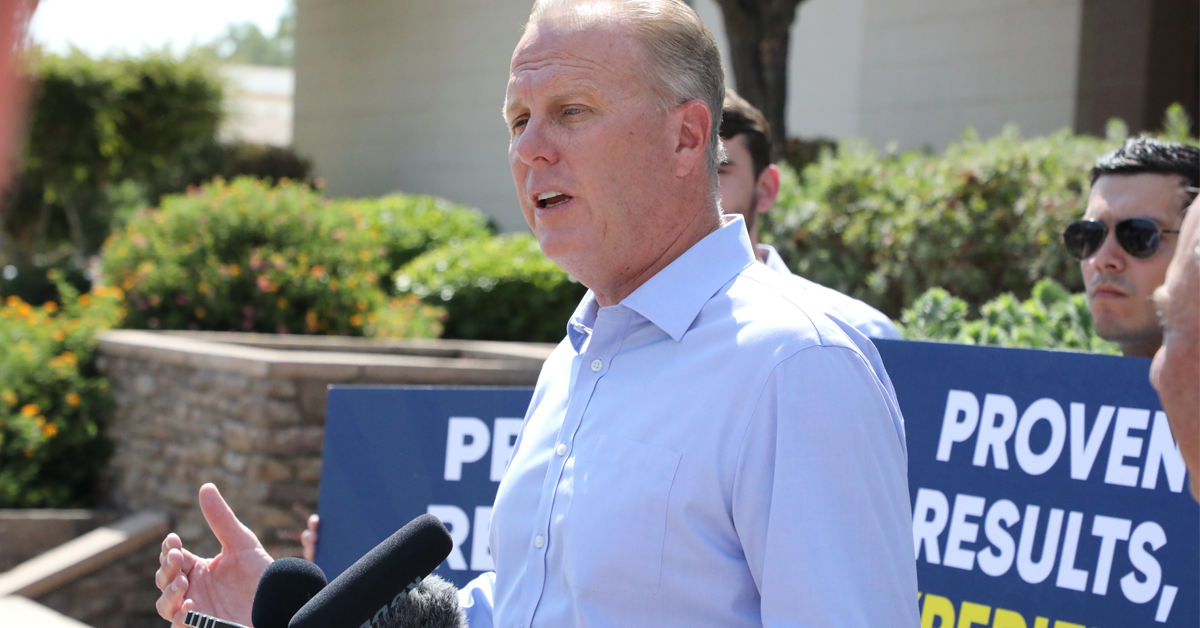With no end in sight to California’s water crisis, former San Diego Mayor Kevin Faulconer visited Fresno to unveil his plan to provide accessible, clean water throughout the state.
Faulconer campaigned outside the Fresno office for the California Department of Water Resources and quickly blamed Gov. Gavin Newsom for the water shortages across the Central Valley.
“This governor has failed our agriculture community by not providing the water resources that our farmers need, that the Central Valley needs,” Faulconer said. “This campaign is going to be all about changes to actually provide the infrastructure, the resources and the political will to help our farmers and our agriculture community.”
Fresno County Supervisor Buddy Mendes joined Faulconer with additional criticism of Newsom and his administration.
Mendes said the state is following the definition of “insanity” by continuing to practice water policies that fail to work.
“Those same things are: you build no more dams or raise any of the dams, you don’t fix conveyance, you throw more water away to the ocean and then you expect different results,” Mendes said. “That’s insanity, because what happens is we keep getting less and less water.”
Faulconer laid out his six-step plan, starting with the creation of additional surface water storage with new reservoir construction as well as additional water recycling infrastructure.
“Increasing our surface water will be my No. 1 priority when it comes to water supply here for the Central Valley,” Faulconer said. “We need to give our agriculture and our farmers the consistency that they deserve, and for far too long these projects have been stopped for all the wrong reasons. It’s time to have a governor again that’s going to stand up and is going to say, ‘We are going to support our farmers in the Central Valley.’”
Next on the list is to provide state funding for canal repairs and other key water infrastructure that will improve the reliability of moving water to California’s residents, farms and businesses.
“If we do not actually take these steps – and some of this money has been allocated for our water bonds – we’re going to continue to see inaction,” Faulconer said. “And what we see time and time again is another drought, but yet we haven’t had a governor that says we’re going to take the actual steps to increase our supply to actually make some changes to doing that.”
Third is to appoint new leaders for water-related state agencies that are supportive of agricultural and rural communities.
Faulconer said those appointments would be about “ensuring that we appoint men and women to our state water boards and agencies that will understand how incredibly important agriculture and farming is to the state when we come to making the decisions that we need to make, when it comes to increasing our supply.”
Fourth on the list is to establish a wildlife strategy based on science instead of what he called “unproven proposals put forward by extremists.”
Next up is to respond to the drought as the emergency that it is. Faulconer said he would use his authority to prioritize water delivery to the communities and farmers that need it most.
The last step in Faulconer’s plan is to connect the most vulnerable communities’ water systems to more reliable supplies so that they are prepared for future droughts.
“As governor, I will take the action that we need, that this valley needs, that our agriculture and farming community needs to get the water supply that they deserve and to treat our farmers and everyone in the Central Valley with the dignity and respect that they deserve when it comes to this issue,” Faulconer said.
“Under the Faulconer Administration there will be a dramatic change. Give us the water resources, the supply that this valley needs and our agriculture community deserves to be successful. This is something I feel very very strongly about, again recognizing that we are the bread-basket of the world here in the Central Valley of California. We’re proud of that. It’s time to have a governor that understands that I will give the support, the resources and increase the supply for our farming and agriculture community.”










